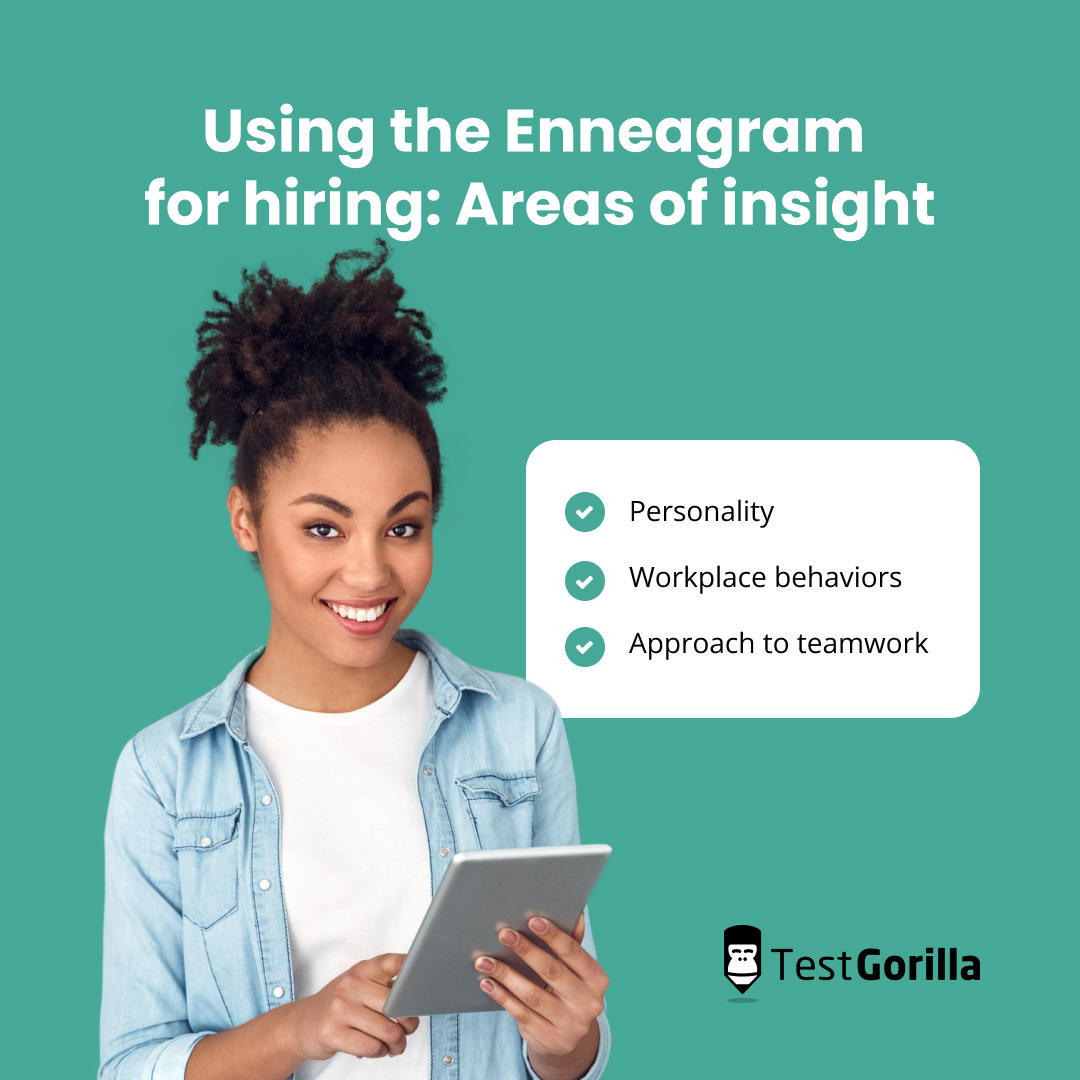Gaining insights into candidates’ personalities during the pre-employment process helps you make sound hiring decisions. There are a range of personality tests you can use to do this, including the Enneagram test.
The Enneagram test plots out nine personality types, revealing more about candidates’ main traits, workplace behaviors, communication styles, and how they work in a team.
It’s been a popular personality test since the 1950s. But its roots can be traced back thousands of years. In this article, we take a closer look at the Enneagram’s origins and how it’s used to aid the hiring process in the 21st century.
Table of contents
Origins of the Enneagram
While the Enneagram is used today as a tool to help understand an individual’s personality, it has spiritual origins.
There is evidence that the first use of the Enneagram symbol dates back thousands of years, although there is disagreement over exactly where it originated. Scholars have linked it to various religions and time periods, including Christian mysticism, Islamic Sufism, and Jewish Kabbalah.
In 1916, the Armenian philosopher George Gurdjieff first coined the term “enneagram” to describe a specific nine-pointed spiritual symbol. Gurdjieff used the Enneagram in his teachings about individuals’ roles and purpose in life, which combined theories from spirituality, psychology, and cosmology.
The first evidence of the Enneagram’s use in understanding personality is in the teachings of Oscar Ichazo, a spiritual teacher from Bolivia, in the 1950s. Under his study of an area called “Protoanalysis,” Ichazo referred to the “Enneagram of Personality” and its related concepts of passions, virtues, holy ideas, and ego-fixations. Ichazo used these concepts to help people achieve self-realization and self-awareness.
A student of Ichazo, Chilean psychiatrist Claudio Naranjo, then applied the Enneagram of Personality in the context of psychology. Narango taught the Enneagram understanding of personality in the US during the 1970s, leading to its continued use today.
Enneagram symbol meaning
The word “Enneagram” derives from the Greek works enneá (nine) and gramma (figure).
The Enneagram is made up of nine points arranged evenly around a circle. Within the circle is a triangle connecting 3, 6, and 9, as well as a hexagonal figure that connects 1, 4, 2, 8, 5, and 7.
In spirituality, the circle shape usually represents “unity” or the natural order of the universe. The triangle refers to the “law of three,” or the three forces necessary for all creation—active, passive, and reconciling—while the hexagonal figure is the “law of seven,” or steps in the transformational process.
When used in a psychological context, the numbered points around the circle each represent a different type of personality. The lines of the inner triangle and hexagonal shapes illustrate how different personality types relate to each other.
The two numbers that appear on either side of an individual’s main personality type are called “wings.” On an Enneagram test, an individual may receive a result that identifies a wing, like Type 1 with a Wing 9 (1w9) or Type 7 with a Wing 6 (7w6).
These wings add more nuance to a person’s core traits, for example, by strengthening or weakening them. Wings may even identify contradictory traits in an individual’s personality that further explains patterns in their behavior.
Recommending reading: Should you include an Enneagram Wings test in your hiring campaign?
Enneagram in the 21st century
The Enneagram continues to be used in a spiritual context today. But it’s more widely known for its use as a psychology tool. Specifically, the Enneagram test delivers insights into a person’s personality, both generally and in certain contexts, for example, in their professional life.
An individual’s personality type reveals details about their fears, desires, and behaviors, especially when under stress. It explores people’s core beliefs—both the positive and negative side of them—as well as patterns in their worldview and the way they control their emotions.
An Enneagram test is used for self-development purposes in a range of contexts, including mental health support, personal coaching, and the workplace, including during the hiring process.
Using the Enneagram for hiring
In a professional context, the Enneagram is often used in pre-employment testing to help recruiters and hiring managers gain insights into a potential hire’s personality, workplace behaviors, and approach to working in a team.
Personality
A person’s Enneagram type can reveal their workplace preferences, for example, whether they prefer to work autonomously or under supervision. It can also help to identify their leadership abilities and style, their best professional attributes, the main challenges they may face, and areas for potential growth. The Enneagram test is also useful for understanding candidates’ intrinsic and extrinsic motivations.
Workplace behaviors
Candidates’ Enneagram test results can also help you understand how they may behave at work. This can include useful insights like how they deal with pressure or how open they are to change.
Enneagram tests can also reveal candidates’ communication preferences and give you tips for communicating effectively with a specific personality type.
Approach to teamwork
An Enneagram test can provide insights into candidates’ abilities to work in a team and their preferences when it comes to team dynamics. This is not only useful for the hiring process but also for understanding how to best manage existing teams in your organization.
These insights are useful background information on candidates applying to any role, regardless of the job-specific skills needed. You can also use many Enneagram test reports to tailor interview questions to specific candidates. TestGorilla’s Enneagram test results, for example, suggest potential interview focus topics based on a candidate’s personality type.
Benefits of using the Enneagram for hiring
There is a range of reasons why you should incorporate the Enneagram test in your pre-employment testing.
Helps you make objective, data-driven hiring decisions
The Enneagram test gives you a better understanding of candidates beyond the factual information contained in their resumes. When used alongside cognitive ability and job-specific skills tests, you can get a fuller picture of a candidate based on data.
What’s more, hiring decisions aided by scientifically tested processes help remove potential bias from the process. This helps you make objective hiring decisions rather than allowing subjective judgments or assumptions to cloud the process.
Improves the quality of hires
A deeper understanding of a candidate and how they work gives you the best chance of hiring the right person for the job.
This is especially true when it comes to culture fit. Personality tests can help you identify candidates whose values align with those of the organization, as well as the organization’s mission. With these insights, you can better predict how someone may fit in a role and what they might add to your company culture.
Increases employee retention
When you hire the best person for the job, they are more likely to stay long-term with your organization.
Pre-employment assessments, including personality tests like the Enneagram test, help you better understand a candidate, what motivates them, and any potential areas of development.
This understanding allows you to improve the employee experience. You have an idea of how to best support the employee, not only to produce their best work but also to ensure they are satisfied and fulfilled in their role.
The more satisfied employees are, the more likely they are to stay with an employer, improving employee retention.
An important caveat
The results of an Enneagram test should never be used to make final hiring decisions. Instead, they should be complementary in the context of a range of pre-employment assessments, including cognitive ability and job-specific skills tests.
Pre-employment testing is also only the first step. It should be used in conjunction with resumes, online and in-person interviews, and other pre-screening tools to help make data-driven decisions and find the best person for the job.
Recommended reading: 10 best Enneagram tests (Free and paid)
Get started with the Enneagram test today
While the Enneagram symbol has its roots in spirituality, these days it’s the basis for a popular personality test widely used in pre-employment testing.
Incorporating the Enneagram test in candidate screening is a great way to remove bias from the hiring process, improve the quality of your hires, and boost employee retention.
If you’d like to learn more about how TestGorilla’s pre-employment assessments, including an Enneagram test, can improve the quality of your hires, check out our online product tour.
Related posts
Hire the best candidates with TestGorilla
Create pre-employment assessments in minutes to screen candidates, save time, and hire the best talent.
Latest posts
The best advice in pre-employment testing, in your inbox.
No spam. Unsubscribe at any time.

Hire the best. No bias. No stress.
Our screening tests identify the best candidates and make your hiring decisions faster, easier, and bias-free.
Free resources
This checklist covers key features you should look for when choosing a skills testing platform
This resource will help you develop an onboarding checklist for new hires.
How to assess your candidates' attention to detail.
Learn how to get human resources certified through HRCI or SHRM.
Learn how you can improve the level of talent at your company.
Learn how CapitalT reduced hiring bias with online skills assessments.
Learn how to make the resume process more efficient and more effective.
Improve your hiring strategy with these 7 critical recruitment metrics.
Learn how Sukhi decreased time spent reviewing resumes by 83%!
Hire more efficiently with these hacks that 99% of recruiters aren't using.
Make a business case for diversity and inclusion initiatives with this data.


















